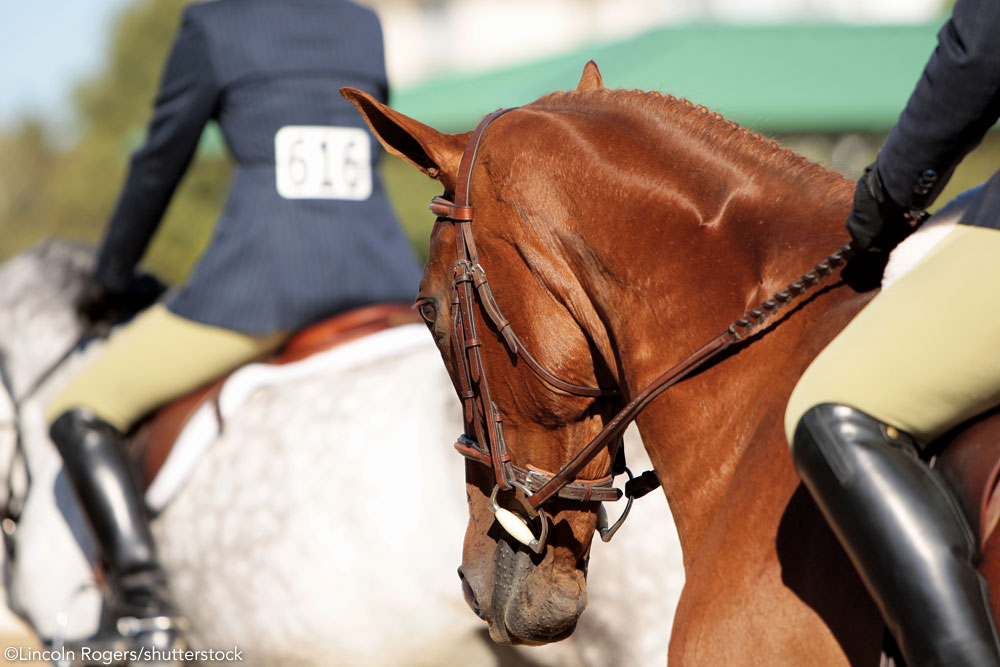Improve Your Handiwork
When it comes to horsemanship, much of the focus is on the proper use of our leg aids. But what about our hands? Horses are great at letting us know when our hand aids are either too rough or simply confusing. If your horse frequently leans on the bit, tosses his head or halts unexpectedly, then you probably need to improve your hand-to-horse connection. Here are some tips to help your hand aids during riding.


Hand Aids During Riding: Develop Your Core Muscles
The first tip to help your hand aids during riding is to make sure you develop your core muscles. Do you rely on your horse’s mouth as a means of support? Over time, this habit makes your horse’s mouth dull and immune to hand aids.
To test your balance in the saddle, knot your reins and hold only onto the excess beyond the knot. If you physically wilt in the saddle and feel generally insecure, you probably lack sufficient muscle tone throughout your torso.
Riding without stirrups produces the optimum results. Start at the slower gaits, a few controlled minutes at a time. If you feel unsteady, grab a handful of mane rather than latching on to your horse’s mouth.
As your core strengthens, advance to cantering without stirrups. Your balance will become independent of your horse’s mouth, and as a bonus, you’ll develop admirable posture.
Hand Aids During Riding: Ride Without Reins
The second tip to help your hand aids during riding is to ride without reins. Reduce your reliance on your horse’s mouth for support by temporarily eliminating—or greatly reducing—your hold on the reins. Needless to say, this exercise must be done aboard a safe, reliable mount and in a round pen or small arena. Riding on a longeline works great, too.
Knot your reins around your horse’s neck so they’re out of the way yet within reach in case of an emergency, then ride in various positions that encourage development of a naturally balanced seat. For example, sit the trot with one hand placed on your hip or atop your head. Then progress to holding your arms folded across your chest, behind your back or held straight out to your sides like airplane wings.
Eventually, try the same thing at the canter. You’ll soon discover that you don’t need to hold on to your horse’s mouth to stay in the saddle.
Hand Aids During Riding: “Wheelbarrow” Reins
The next tip to help your hand aids during riding is to hold the reins as if you were to hold a wheelbarrow. Does your riding instructor frequently tell you to “let go” so your horse can canter or jump freely? Your hands are probably too restrictive.
To create a more forgiving pair of hands, hold the reins as you would grasp the handles of a wheelbarrow: Keep your thumb, which is pinching the rein against the top of your index finger, pointed toward your horse’s mouth. If you glance down, you’ll see your thumbnails.
You’ll still be able to control and guide your horse, albeit with smoother, less abrupt cues. Gone is your ability to nervously shorten the reins or rotate your wrists to increase your hold. As a result, your horse will move freely forward, especially over jumps, where he can now use his body effectively.
How’s your Handshake?
The last tip to help your hand aids during riding is to always make sure you have a solid connection with your horse. Think of the contact with your horse’s mouth as being similar to holding hands with a small child or dear friend: Sure, you can feel their presence in your hand at all times, but the contact is consistently gentle. Only when you want to convey a specific request, like, “Wait! Stop here,” or, “Come in this direction,” does your grip increase and become active.
Ideally, this is how you should view your connection via the reins. The majority of the time your contact is present, yet relaxed (passive). When you want to convey a message to your horse regarding direction, pace or collection, your contact increases (becomes active). Once your horse responds, reward him by relaxing your contact once again.
This concept will lead to better communication with your hand aids and develop your partnership with your horse.
This article originally appeared in the January 2019 issue of Horse Illustrated magazine. Click here to subscribe!
Recent Posts
Breed Profile: European Brabant
While draft horses come in many shapes and sizes, from the gigantic Shire to the smaller Haflinger, most have something…
The Working Mules of our Public Lands
Flopping ears bounce with every step down the trail as a string of six mules begin the trek from the…
Sabrina Lewis and Her Crowning Achievements
Speaking on a stage surrounded by the glitz and glamour of the Miss America Pageant, Sabrina Lewis stands out with…
Equine Insurance Policies
Insurance. It’s a fact of life for most adults. We insure our vehicles, homes, businesses—even our smartphones. We buy life…
2025 Defender Kentucky Three-Day Event
Stay up to date on the action from the 2025 Defender Kentucky Three-Day Event. Find information about the event, including…
Cosequin® Lexington 4*-S at Defender Kentucky Three-Day Event presented by MARS Equestrian™ to Serve as US Equestrian Open Eventing Series Qualifier
Lexington, Ky. — This year’s Cosequin® Lexington 4*-S will serve as a US Equestrian Open Eventing Series Qualifier when the…